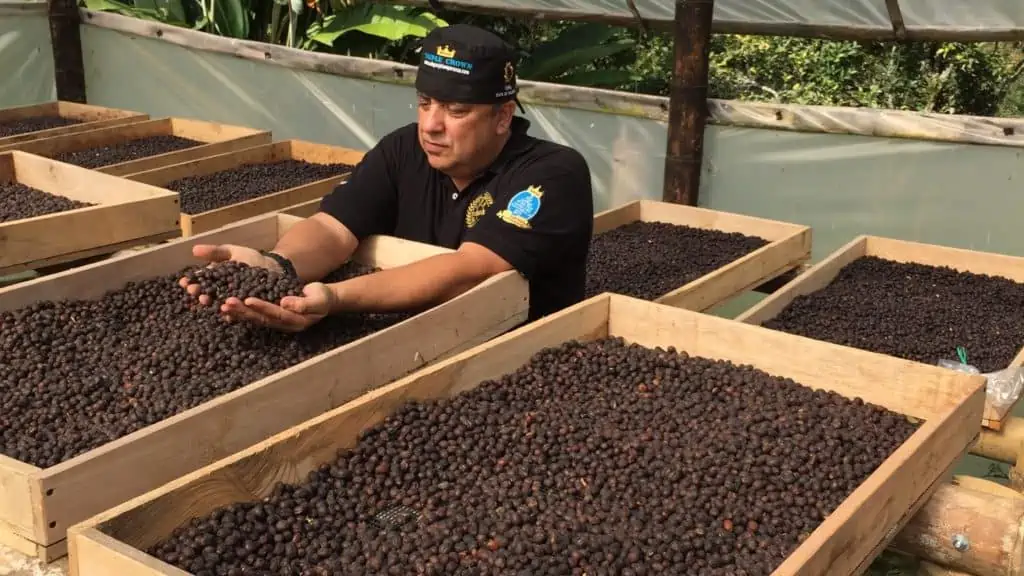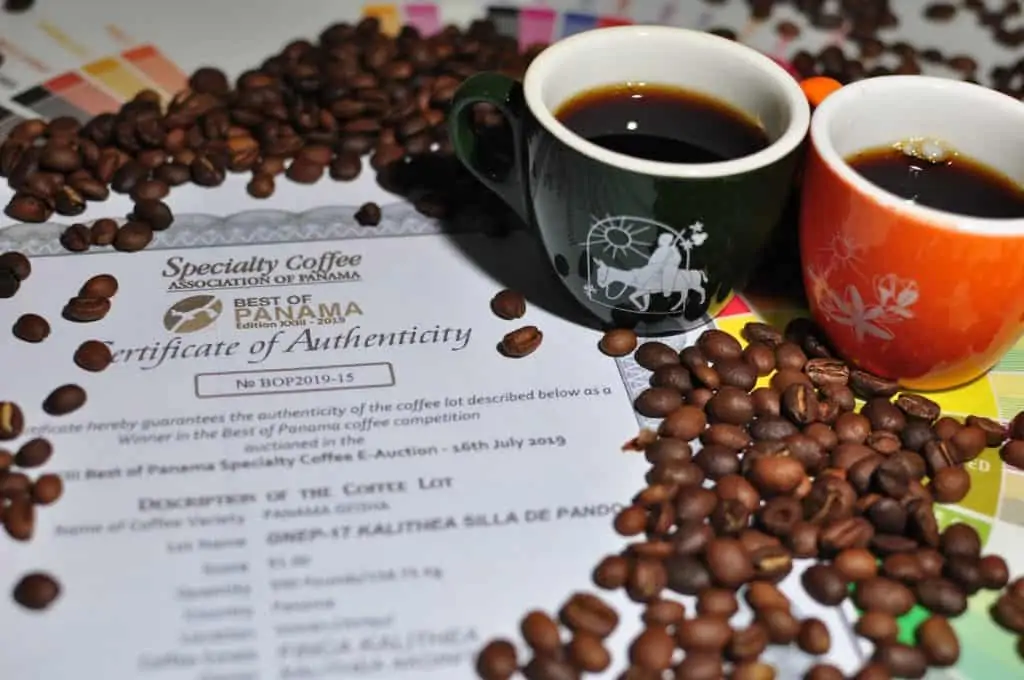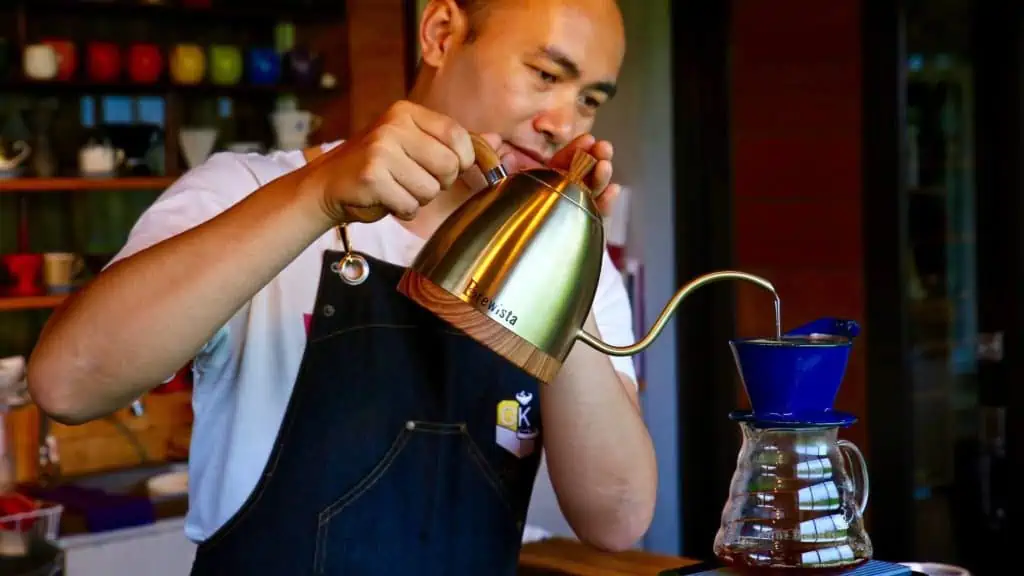When we last wrote in depth about Geisha (also spelled Gesha) coffees in 2017, a 100-pound lot of this prized variety of Arabica, grown at Hacienda La Esmeralda by the Peterson family, had just broken the then-current record for the highest price ever paid for a green coffee: $601 per pound. Flash forward to July of this year, when that record was shattered by the Lamastus family, whose Elida Estate natural-processed green-tip Geisha sold at the annual Best of Panama auction for $1,029 a pound. Spoiler alert: The Elida coffee earned the top score in our cupping this month of Geisha coffees, an impressive 97. So, yes, it’s good. Very, very good.
But when one considers that the average price per pound of a high-grown, high-grade Arabica coffee sold through the commodity system is currently barely over one dollar per pound ($1.0035 at this moment, to be exact), what does this huge discrepancy say about the state of coffee as an industry? Is it hollowed out in the middle, increasingly divided between a tiny prestige-chasing elite and a vast, anonymous commodity machine?
Of course, from a pleasure-driven sensory perspective, even decent commodity-grade coffees like the 100% Colombias one finds on supermarket shelves (which probably fall roughly into the buck-a-pound-green price category) bear little resemblance in the cup to a fine Panama Geisha. But neither do such straightforward commodity coffees have much in common with the many fine non-Geisha specialty coffees we often rate at scores of 93 to 95, and which probably cost roasters somewhere around $4 a pound. In this context, these record-breaking auction prices for Geishas seem absurd.

Farmer Rigoberta Herrera, of Granja La Esperanza in Colombia, checking Geisha fruit as it dries. Courtesy of Bird Rock Coffee.
Barry Levine, of Willoughby’s Coffee & Tea in Connecticut, secured eight pounds of the Elida Geisha. Levine is a pioneer in the specialty coffee industry and the longest-standing juror at the Best of Panama competition. While he acknowledges the disturbing dichotomy represented by these extremes at either end of the price scale, he has also witnessed, firsthand, the evolution in quality of Panama Geisha, and he compares these small, highly allocated auction lots to what we routinely see in the wine industry. Cult Cabernet Sauvignons from Napa and first-growth Bordeaux wines — which, unlike coffee, are designed to get better with age — often sell for thousands of dollars a bottle. (In 2018, a single bottle of 1945 Domaine de la Romanée-Conti sold for $558,000.)
And, apart from the excesses of certain auction coffees, even the finest specialty coffee remains very much underpriced, particularly from a producer perspective. See editor Kenneth Davids’ article, “Coffee’s Economic Paradox: $40 Charged in Paris, $3 Paid in Kenya” for some reflections on today’s specialty coffee prices and their relationship to producers.
Why Is Geisha the Darling of the Specialty Coffee Industry?
Why Geisha? What is the particular appeal of this relatively rare variety of Arabica? Geisha was discovered in the Gori Gesha forest of western Ethiopia in the 1930s by British Consul Richard Whalley (in the general vicinity of where the Coffea arabica species itself is thought to have originated). From there, it was carried, relatively anonymously, to East Africa, then Costa Rica, then finally to the Peterson farm in Panama. The Petersons introduced it to the Best of Panama auction in 2004, where it blew the jurors away with its extraordinary aromatics and flawless structure. Essentially, it was unlike any other coffee on the table.
We at Coffee Review have cupped hundreds of Geisha coffees over the years and can confirm its distinctive character. While not all Geishas rise to the level of an Elida or a Hacienda La Esmeralda, the best are abundantly floral, uniquely fruit-toned, and richly cocoa-laden. They really are categorically different from the rest of the world’s coffees. True, the finest coffees produced from indigenous “landrace” Ethiopia varieties often come close to Geisha’s aromatic fireworks, but they are never quite as vast and intricate in their aromatics, nor as authoritative in their structure. And the success of Panama Geishas at auction, along with their demand in the specialty coffee market, has caused farmers in just about every coffee-producing region in the world to try their hand at producing them.
This month’s report features the top-scoring Geishas we cupped from Panama, Ethiopia, and Colombia, ranging in score from 94-97.
A Rose By Any Other Name
Before we get into the details of these nine extraordinary coffees, a brief note about the spelling of Geisha/Gesha. In short, the spelling of this word is quite controversial! Last year’s article in Sprudge, “Stop Calling It Geisha, Already,” by Jenn Chen, argues that “Gesha” is the correct spelling because the coffee was first identified in the Gesha Gori forest, and that the British expedition that found the coffee mislabeled it as “Geisha.” But the Peterson family remains steadfast in its embrace of “Geisha” as the proper name, given that all the official documents related to this coffee’s arrival in Panama spell it that way. Our solution? We go with what the producer prefers. Most Ethiopia producers spell it as “Gesha,” and understandably so, while, most producers in Central and South America spell it as “Geisha,” with the exception of Ninety Plus Coffee, which grows in both Panama and Ethiopia; founder Joseph Brodsky goes with “Gesha.” (Just this week, one of Brodsky’s experimental coffees sold for a reported $10,000 a kilo in Dubai.)
The Nine Top-Scoring Geishas
Of the more than 40 samples submitted from five coffee-producing origins (Panama, Colombia, Ethiopia, Costa Rica, and Guatemala), we rated one from Panama, the Elida Green-Tip Geisha Natural roasted by Willoughby’s Coffee & Tea, at 97; we rated three additional Panamas at 96, 95, and 94; two Colombias at 96, and three Ethiopias at 94.
Mind-Blowing Aromatics at the Top
The Willoughby’s Geisha was truly ethereal, a nuanced, exceptionally lush cup with notes of aprium, star jasmine, pistachio butter, cocoa, pink peppercorn and almond brittle. Levine says it was particularly nerve-wracking for his roaster, Jeff Cannon, to nail the roast profile with only 80 grams of coffee to work with. Because Willoughby’s had only eight pounds total, it was imperative that they waste as little as possible. They sent 50 grams for us to cup and cupped the remaining 30 grams themselves. The plan is to sell it as an experience, in a boxed set that includes 1/4 pound of the coffee along with commemorative items still being considered. Levine may also hold a tasting event for $100 a cup.

The Best of Panama certification for Kakalove Cafe’s lot of the Finca Kalithea Panama Geisha. Courtesy of Kakalove Cafe.
At 96, the Panama Finca Kalithea Natural Geisha roasted by Kakalove Café in Taiwan is a high-toned, delicately fruit-centered cup with notes of mulberry, coconut, sandalwood, dark chocolate and lilac. And at just 750 Taiwan dollars (approximately $24 USD) for four ounces, it’s worth ordering a bag to do a side-by-side. They’re very different coffees, and both very worthy.
Relative Bargains from Colombia
We also rated two Colombia Geishas at 96, a Valle de Cauca natural-process roasted by Bird Rock Coffee in San Diego and a Finca La Maria Geisha Natural roasted by Klatch Coffee in Los Angeles. The former is a savory-sweet cup with notes of chocolate fudge, ripe wild strawberry, honey, macadamia nut and fine Roquefort cheese, while the latter is a cleanly fruit-toned natural with notes of dried raspberry, halvah, plumeria, pink peppercorn and lemon verbena. Both are a relative bargain at $60 and $54.95 for eight ounces, respectively.
A Uniquely Composed Washed-Process Panama
Boulder, Colorado’s Dragonfly Coffee submitted a Panama Hacienda La Esmeralda Super Mario 6 Geisha, the most unusual of the top-scorers in that it forgoes the more common delicately fruit-toned profile for an overtly umami-centered approach, with a throughline of white peppercorn ensconced in lush florals, deep chocolate, and crisp pear notes. It’s a coffee with a distinct personality that invites you to get on its wavelength and is perhaps the most polarizing of the Geishas reviewed this month. We love it, as it defies expectations in the best possible way. It’s available for $60 for eight ounces on the Dragonfly website.
A Panama, a Colombia, and Two Ethiopias at 94
Caffe Luxxe’s Panama Alto Jaramillo is one of two Panama Geishas reviewed here that is a washed-process coffee (and one of only three washed Geishas on this list of nine). It’s austere only in comparison to the unabashedly fruit-forward naturals; in and of itself, it’s exquisitely balanced, crisply and sweetly bright, with notes of tangerine zest, lavender, cocoa, cedar, and fresh apricot ($40 for four ounces).
Based on the two exceptional Ethiopia Geshas (one natural-processed and one washed) we review here, there is potential for a broad range of sensory pleasures from Geshas emerging from their original home. Both were produced by Adam and Rachel Overton at Gesha Village Estate in the Bench-Maji Zone of southern Ethiopia. The washed coffee, roasted by Mudhouse Roasters in Charlottesville, Virginia ($50 for eight ounces) is richly sweet-savory and deeply floral-toned, with notes of honeysuckle, bergamot, toffee, myrrh and a surprising (but pleasing) hint of fresh coriander. The natural Gesha was roasted by Taiwan-based GK Coffee (1200 Taiwan dollars, about $38.75 USD, for 100 grams), a balanced, sweetly tart cup with notes of honey, lilac, guava, frankincense and cacao nib.

Gary of GK Coffee in Taiwan, serving coffee in his shop. Courtesy of GK Coffee.
The remaining 94 is the Laderas Del Tapias Estate Natural Colombia, roasted by Cafetaster in Taiwan (1350 Taiwan dollars, $43.50 USD for 230 grams), thoroughly berry-toned with notes of baking spices and cocoa throughout and a subtle hint of sweet fruit ferment.
More Questions In Lieu of Conclusions
It’s not really possible to answer all the questions raised by the Geisha/Gesha variety’s startling success across the world. What’s clear is that we’re going to be seeing much more of it in the coming years, and from origins beyond its original home, Ethiopia, its pioneering adopted home, Panama, and rising star Colombia. Coffees we don’t have space to report on here that performed very well include a Geisha from Costa Rica at 93 and one from Guatemala at 92. One might argue that the proliferation of this variety across many origins, if quality continues to improve, will benefit farmers by commanding higher prices and elevating the perceived status of coffee production, generally. Or it may just drive a wedge between coffee for the one percent and coffee for the rest of us. It’s hard to predict, but the emphasis on quality that Geisha has brought with it — because of its relative rarity and the precise conditions it needs to be grown successfully — can only be viewed as a positive.










